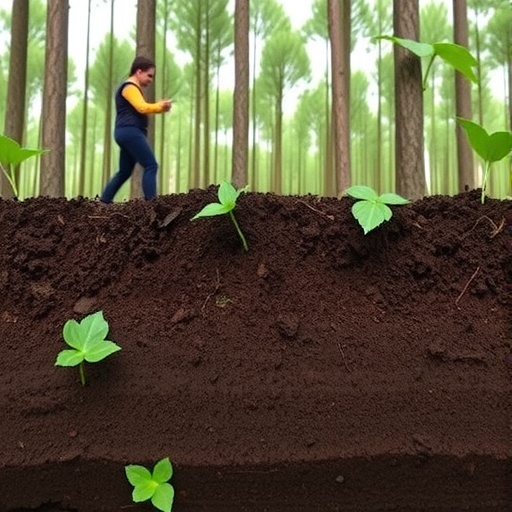As global societies continue their relentless quest for land to accommodate agricultural needs and urban expansions, the impacts of these transformations on natural ecosystems become increasingly apparent. The act of converting vast stretches of forests into fields or urban areas has far-reaching consequences that stretch beyond mere aesthetic changes to landscapes. Researchers Zhou, Liu, and Wang, along with their collaborators, shed light on one of the most alarming effects of this phenomenon: the homogenization of soil biota, which significantly compromises the functions and stability of ecosystems.
The significance of soil biota cannot be overstated. Comprising an array of microorganisms, fungi, and invertebrates, soil biota play pivotal roles in nutrient cycling, organic matter decomposition, and soil structure maintenance. As ecosystems become homogenized due to forest conversions, the once-diverse communities of soil organisms begin to lose their variation and unique functional traits. This loss of diversity in soil biota results in decreased resilience against environmental changes and disturbances, positioning ecosystems on a precarious edge.
High degrees of soil biota homogenization can be attributed to several factors associated with land-use changes. Primarily, when forests are converted for agriculture or built environments, native vegetation is often removed, subsequently disrupting the intricate relationships that soil biota had with their ecological counterparts. Moreover, soil compaction from heavy machinery further exacerbates the loss of habitat and thus diversity within soil biota. These combined stresses force soil organisms into a homogenized state where fewer species dominate, leading to diminished ecological functions.
The research undertaken by Zhou and colleagues posits that ecosystem functions—such as carbon sequestration, water filtration, and resilience to invasive species—are jeopardized when soil biota diversity is diminished. Moreover, the research reveals that homogenized soil biota are less capable of responding to disturbances such as climatic fluctuations or pest invasions. Thus, as global temperatures rise and weather patterns become more erratic, the implications of reduced soil biota diversity could ripple through the food chain, ultimately threatening food security for human populations.
In examining various forest-to-agriculture conversion scenarios, the team observed clear trends of declining species richness—an observation that supports the hypothesis that monoculture farming significantly contributes to biota homogenization. When land is allocated to single crop rotations, the result is often a drastic reduction of species richness in both plant and soil communities. With such reductions, ecosystem functions that are crucial for human sustenance and environmental integrity begin to falter.
One of the striking conclusions from the study highlights the speed at which biota homogenization occurs. The transition from forests to agricultural plots does not merely act as a linear trend but can manifest within a single growing season. As invasive species often take hold in disturbed areas, the consequences of land conversion can manifest rapidly, providing scant time for native species to recover or adapt. This rapid rate of change poses significant challenges for conservation efforts aimed at restoring native ecosystems.
Addressing these challenges necessitates innovative solutions and strategies for land management. One approach involves adaptive management frameworks that prioritize biodiversity through diverse planting techniques and integrated farming practices. Agroecology, for instance, emphasizes the importance of maintaining varied species in agricultural landscapes, thereby enhancing soil health, promoting diverse soil biota, and ultimately bolstering ecosystem functions.
Furthermore, reforestation efforts in previously converted lands can yield positive outcomes for restoring soil biota diversity. Research suggests that even on previously degraded lands, efforts to reintroduce native forest species can revitalize soil ecosystems and foster biodiversity recovery. This process not only enhances the soil biota community but also mitigates some negative impacts of past land-use practices, promoting a more resilient agricultural system for the future.
Public awareness of these issues is also crucial. Educating communities about the importance of maintaining diverse ecosystems can lead to more sustainable land-use decisions. Citizens empowered with knowledge about the direct advantages of biodiversity—such as improved soil quality and enhanced climate resilience—are more likely to advocate for practices that balance human needs with ecological integrity.
Finally, the ramifications of their findings extend beyond scientific communities; they resonate with policymakers and land managers who hold the stewardship of our planet in their hands. Legislative frameworks can support biodiversity conservation efforts by incentivizing practices that encourage varied land uses, such as agroforestry and permaculture. In this way, human progress need not come at the expense of ecological stability, forming a harmonious alliance between economic development and environmental stewardship.
In conclusion, the study by Zhou, Liu, Wang, and their collaborators identifies a pressing issue: the interference of forest conversion in soil biota diversity and, consequently, ecosystem stability. Understanding these dynamics is not merely an academic pursuit; it is a clarion call for action. By prioritizing biodiversity within land stewardship practices, we can mitigate the profound impacts of homogenized soil biota and foster a more sustainable future that embraces both human advancement and environmental protection.
Subject of Research: Soil biota homogenization due to forest conversion and its impact on ecosystem functions.
Article Title: Forest conversion-induced soil biota homogenization destabilizes ecosystem functions.
Article References: Zhou, X., Liu, S., Wang, B. et al. Forest conversion-induced soil biota homogenization destabilizes ecosystem functions. Commun Earth Environ 6, 882 (2025). https://doi.org/10.1038/s43247-025-02909-7
Image Credits: AI Generated
DOI: https://doi.org/10.1038/s43247-025-02909-7
Keywords: soil biota, ecosystem functions, biodiversity, forest conversion, land-use change, agroecology, reforestation, environmental resilience.




